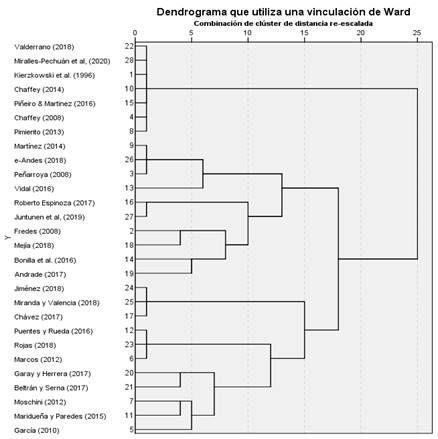
Figure 1. Cluster análisis
Source: Own elaboration
Digital marketing management in tourist organizations
(*)Noel Fernández Cueria; (**)Elizabeth del Carmen Pérez Ricardo; (***)Justa Ramona Medina Labrada; (****)Katia Zucel Coronado Provance; (*****)Francisco Fidel Feria Velázquez
(*)Department of Tourism, University of Holguín
Holguín, Cuba
noelfercueria@gmail.com
(**)Department of Tourism, University of Holguín
Holguín, Cuba
eliza941025@gmail.com
(***)Department of Tourism, University of Holguín
Holguín, Cuba
elizabeth.ricardo@uho.edu.cu
(****)Department of Tourism, University of Holguín
Holguín, Cuba
kcprovance@uho.edu.cu
(*****)Department of Tourism, University of Holguín
Holguín, Cuba
ffr@gmail.com
Reception date: 10/18/2021 – Approval date: 12/09/2021
DOI: https://doi.org/10.36995/j.visiondefuturo.2022.26.02.006.en
ABSTRACT
Digital marketing has changed the way businesses operate at an international level, taking into account the boom that the use of information and communication technologies has reached. In tourism organizations, these tools play a fundamental role in the process of acquiring new customers, retaining and creating relationships with them in order to promote and sell the organization's products and services. In this context, digital marketing is an essential strategy for brands due to the great opportunity for growth, positioning and dissemination that they represent. The general objective of this research is to develop a procedure for the management of digital marketing in tourism organizations that favors their commercialization process. For this, different theoretical, empirical and statistical methods were used, which allowed the design of the proposed procedure. The application of this procedure at the Brisas Guardalavaca hotel allowed perfecting the tools of social networks, electronic commerce and email marketing, thus raising the interaction indicators. In addition, the causes that cause deviations in the positioning and website were analyzed, for which alternatives materialized in an action plan were proposed.
KEYWORDS: Digital marketing; Tourism management; E-commerce; Web positioning; Social media.
INTRODUCTION
The importance of digital marketing increases with the inclusion of information and communication technologies (ICTs) in organizational management models, which has caused a change in the way businesses operate globally. Tourism companies, in turn, demand new and practical models, adjusted to this context, that allow their link to the world of electronic commerce and that guide them in how to enter and sustain themselves, thus avoiding that the resources assigned to these institutions are poorly invested in the implementation of imported or outdated models that little or nothing obey the situations of the environment (Minazzi, 2015). Digital marketing is leading the way in offering new features to reach, inform, engage, offer, and sell products and services to customers, and is expected to continue at the forefront of the technological revolution (Kim, Kang, & Lee, 2021).
The use of digital marketing in tourism organizations allows for a qualitative leap in the management of the value chain, guaranteeing competitive advantages and building customer loyalty with the brand. Currently, the abundance of data and rapid technological advances in the digital field have caused transformative consequences for marketing practices (Shah & Murthi, 2021). Digital marketing actions should not be limited to transferring advertising from traditional media to the web, promoting products through the new ways that technology facilitates or gaining customer trust, but must be conceived as a whole to obtain a transparent and coherent experience. , improve marketing productivity and connection with the consumer in order to build loyalty.
Research on digital marketing has experienced growth in recent decades, parallel to the consolidation of university studies in this area of knowledge. Starting from the criterion that digital marketing is a novel area of knowledge and what has been published about it is contextualized in the informational field, there is an urgent need to investigate its chronological and thematic growth in the sphere of tourism; as well as its behavior according to the different geographical areas. Many authors approach the subject from different perspectives, Truong, Simmons, and Palmer (2012); Rebón, Ocariz, Gerrikagoitia, and Alzua-Sorzabal (2015) y Shankar et al. (2016) agree that digital marketing management in organizations is a key process to achieve success. Rapid changes in digital consumer behavior require timely and sophisticated responses from tourism organizations to these consumer needs (Tupikovskaja-Omovie & Tyler, 2021).
For this research 21 definitions were analyzed in which tools or action channels are proposed for the management of digital marketing in tourism organizations, however, among these there is no consensus about which are the most important at the time of its implementation, according to the authors consulted (Cleff, 2010), (Lin, 2014), (Ahmad, Musa, & Harun, 2016), (Barcelos, Dantas, & Sénécal, 2018), (Erkollar & Oberer, 2016), (Xu, Frankwick, & Ramirez, 2016), y (Ranfagni, Crawford Camiciottoli, & Faraoni, 2016) those that have the greatest impact on the management of digital marketing and the value chain of companies are: social media, branding, big data, e-commerce , interactive marketing and advertising. However, these digital marketing tools are not merged in the literature, an element that is essential for its proper management in tourism organizations.
In this sense, the studies consulted on digital marketing in tourism organizations (Peñarroya, 2008), (Chaffey & Smith, 2008; Giraldo, Gomes, & Mesquita, 2019), lack a logical sequence for its application in organizations. These require incorporating digital marketing principles where customer feedback and loyalty is essential and the goal is not to have the advertising with the greatest reach, but rather the one that manages to maintain constant interaction and conversion. In addition, they do not have a management focus, but only cover some of the functions of the cycle, independently. The foregoing shows deficiencies in the theoretical-methodological body to adequately develop digital marketing management in tourism organizations.
In the analysis of the state of the practice, several authors have carried out studies of the digital environment in different tourist organizations in the Holguín destination. As a summary Guevara Ricardo (2020), states that the lack of a comprehensive approach to digital marketing management prevents the unification of the different tools available to achieve the proposed objectives. In this sense, Pérez Velázquez (2020), agrees that it is necessary to break the existing isolation between the flow and functionality of the tools used and extend them towards customer feedback and loyalty in destination tourism organizations. For his part, Camejo Peña (2020), asserts that those in charge of the proper functioning of digital marketing management do not yet have sufficient experience in evaluating actions in this area and that the improvements made to the tools used are do empirically.
As a result of the above, a diagnosis of digital marketing was carried out in some tourist organizations of the Holguín destination, which are considered representative: Playa Pesquero hotels, Brisas Guardalavaca, Club Amigo Atlántico, the Cubatur Holguín travel agency and the Palmares Holguín branch; Based on the documentary review based on commercial reports of the destination, interviews with tourism managers of the territory and the analysis of publications on websites (www.holguintravel.cu, www.infotur.cu, www.gaviotahoteles.cu, www. hotelscubanacan.com and www.brisasguardalavaca.com), profiles of organizations on social networks such as Facebook, Instagram and Twitter and opinion sites such as TripAdvisor, HolidayCheck and Monarc. From these analyzes it was obtained that in recent years the number of searches for terms related to the name of the tourist organizations of the destination in the Google search engine has decreased. These organizations do not have their own website or have an outdated interface. Good management of social networks, specifically Facebook, is carried out, however, interaction with customers on this site is insufficient. Likewise, search engine optimization tools (SEO or SEM) are not used. Although there is a growth trend in online commerce, mainly in the B2B mode, it is not yet representative in terms of the volume of operations of these organizations and the parameters for the control and measurement of the actions carried out in the field of digital marketing have not been defined.
The shortcomings detected from the theoretical-methodological and empirical point of view demonstrate the existence of the following scientific problem: insufficiencies in the management of digital marketing that limit the marketing process in tourism organizations. Due to the above, this research aims to develop a procedure for the management of digital marketing in tourism organizations that favors their marketing process. For this, two fundamental objectives were proposed, the first to design a procedure for the management of digital marketing of tourist organizations that favors their commercialization process and the second to evaluate the relevance of the proposed procedure from its application in the Hotel Brisas Guardalavaca.
The field of action of the research is the management of digital marketing in tourism organizations. To solve the exposed scientific problem, the following hypothesis was formulated: the application of a procedure for the management of digital marketing in tourist organizations that integrates the analysis of social networks, positioning, email marketing, electronic commerce and websites, contributes to perfecting the marketing process.
The article is structured in five sections: introduction, where the research design is based; methodology, where the designed procedure is explained; results and discussion, in which the proposed procedure is implemented in the Hotel Brisas Guardalavaca; conclusions derived from the investigation and bibliographical references.
DEVELOPMENT
Metodology
For the analysis of the bibliographies that address the management of digital marketing, a conglomerate study was carried out. To make the groups, the four components of digital marketing (flow, functionality, feedback and loyalty), the application of these studies to the tourism sector and the proposal of tools, strategies or models for their application were taken into account as variables. The conglomerate was carried out by observations through SPSS version 20 and the WARD method was used, square Euclidean distance, and level 7 was taken as the cutoff line, with which the dendrogram that can be seen in Figure 1 was obtained, identifying seven groups of authors whose main contributions and shortcomings were analyzed.

Figure 1. Cluster análisis
Source: Own elaboration
The review of these methodologies allowed us to identify that they lack a logical sequence for their application in tourism organizations. These tools require incorporating digital marketing principles where customer feedback and loyalty is essential and the goal is not to have the advertising with the greatest reach, but rather the one that manages to maintain constant interaction and conversion. In addition, they do not have a management focus, but only cover some of the functions of the cycle, independently. For this reason, a new methodology is proposed where the contributions made by previous authors are integrated and new elements necessary for an effective management of digital marketing in tourism organizations are incorporated. Figure 2 shows the new proposal for the management of digital marketing in tourism organizations.
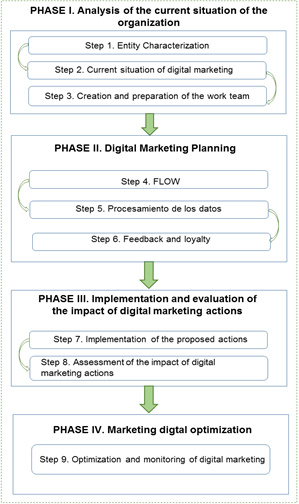
Figure 2. Procedure for the management of digital marketing in tourist organizations
Source: Own elaboration
PHASE I. Analysis of the current situation of the organization
Phase I aims to analyze the organization in terms of its characterization, the current situation of digital marketing and the creation of a work team for the application of the tasks of the procedure. This is composed of three steps, in the first a description of the entity and the tourism marketing system is made, which will allow knowing its particularities, so that they serve as a basis for subsequent steps.
In the second step of the procedure, an analysis of the internal and external situation of the tourist organization is carried out, taking into account the positioning, social media, corporate website, email marketing and electronic commerce, for which a set of indicators are proposed that will allow us to know the current status of the tools mentioned above. Finally, step 3 is carried out, for which the creation and preparation of a work team is proposed, which will be constituted by the committee of specialists. To carry out the analysis effectively, the members must be well prepared in the topics to be developed. This step includes the creation of the plan to develop the actions.
PHASE II. Digital Marketing Planning
Phase II aims to plan digital marketing actions based on the four fundamental strategies for its application. This phase is made up of four steps, in the first one the implementation of a presence is proposed that will allow to start or increase the flow of target audience in the field of digital marketing. It is mainly based on the use of Social Media Marketing without neglecting other tools such as the corporate website. For this, it will be registered in all possible social networks, although in the first instance it will only focus on two or three, these networks will be the ones most used by customers who usually make use of the organization's products or services. Often the generation of content is proposed with the aim of providing information about the organization's products or services, disseminating this content to ensure that it leads to a sale.
In step number two, different actions are proposed to implement or correct the functionality of our digital tools. This stage mainly uses the corporate website and search engine optimization. While in the third step e-commerce tasks are included in its two fundamental areas, B2C and B2B. Finally, it is proposed to monitor the mentions of the organization, customer service on social networks and corporate website and implement an email marketing system that favors feedback and customer loyalty.
PHASE III. Implementation and evaluation of the impact of digital marketing actions
In this phase, the steps determined in the previous phase are put into practice, in addition, the impact of these actions is analyzed by establishing metrics to assess digital marketing actions in the organization, in addition, the impact of the results is analyzed to determine the effectiveness of the proposed actions. Once the results are available, the impact of the indicators must be thoroughly analyzed, fundamentally those whose measurement criteria were deficient. In addition, the causes must be investigated to find all the information related to it.
PHASE IV. Marketing digtal optimization
The objective of this phase is to propose solutions to the deviations detected based on the causes that cause them. To this end, actions aimed at generating alternatives to the deficiencies found during the assessment of digital marketing actions and the development of an action plan to solve them are proposed.
Results and discussion
Analysis of the current situation of the Brisas Guardalavaca Hotel
The Hotel Brisas Guardalavaca, is part of the Cubanacán Group, belonging to the Ministry of Tourism (MINTUR), is located in the tourist area of Guardalavaca, is located in the coastal area of the province of Holguín, belonging to the Banes municipality. The complex currently has 437 rooms including the two sections: the hotel and the villas, which bear the name of the first nine villas founded in Cuba. It has a four-star category with an all-inclusive service offer. The five main markets for Hotel Brisas Guardalavaca are Canada, England, Germany, Cuba and Russia as of 2018.
Current situation of digital marketing
To define the current situation of digital marketing at the Hotel Brisas Guardalavaca, different indicators were measured in the period from September to December of the year 2018 due to the availability of the data and to create a starting point for the application of the actions, in the which the following results were obtained.
Positioning
For the analysis of the positioning, a search was carried out in the Google search engine using the words: Hotel Brisas Guardalavaca. As a result, it was observed that the facility's website is on the first search page, which is favorable for positioning. However, there are seven pages of travel agencies that market this hotel that are in a better position, so the result can be optimized.
In addition, the search in Google Trends for the term Hotel Brisas Guardalavaca was carried out, in the period 01/2012 - 12/2018, observing a considerable decrease in the search frequency and a tendency to continue in that way, as shown in Figure 3.
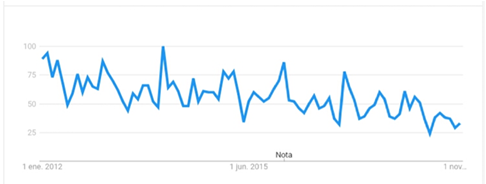
Figure 3. Brisas Guardalavaca in Google Trends
Source: Google Trends
Electronic commerce
Electronic commerce is present in two of its modalities (B2C and B2B) at the Hotel Brisas Guardalavaca, an analysis of each of these was carried out and the following results were obtained.
B2C:
-Distribution logistics: on the facility's website there is everything related to the purchase price associated with the desired number and volume of rooms.
-Shopping cart: this option is present to carry out the pre-reservation of the selected rooms
-Credit or electronic payment: there is no payment gateway on the website that allows electronic payment, however, the pre-reservations made in the system are kept until the day of the client's arrival.
-Registration process: the registration process is simple, so it was determined that it does not influence the sales process in the installation
-Security certificate (SSL): there is no security certificate as there is no payment gateway
In summary, it was evidenced that, although the website provides the user with all the information related to the price and the possibility of reservation, there is no payment gateway that guarantees the installation a monetary support for it.
B2B: this type of business is one of the fastest growing at the international level. This is fully regulated by the parent company as it is the one in charge of defining contracts with online agencies from other countries. However, as a strength, Grupo Cubanacán has a sales website or CRS in which agencies can find out about availability and make direct reservations together with payment depending on what is agreed in the contract.
Email Marketing
Regarding the use of email marketing in Brisas Guardalavaca, in an interview with the commercial and public relations team, it was found that there is a database, but only associated with the loyalty program, so only customer emails are registered in it. repetitive. This database allows segmentation by country, which is one of the main aspects to carry out campaigns of this type.
On the other hand, no tool is used to manage email marketing, so the effectiveness of this tool cannot be measured. The use of this technique is limited to sending invitations for the hotel's biggest event, which is the anniversary, and it is also used on specific occasions as a means of information in exceptional situations such as cyclones and others.
Social Networks
For the calculation of the main metrics of social networks, the following equation was used:
(1) KpiRS = (Kpif + Kpit + KpiI + KpiYt) ÷ 4= 0,208
For the evaluation of social networks, the elements shown in Table 1 were taken into account.
Table 1. KpiS of social network
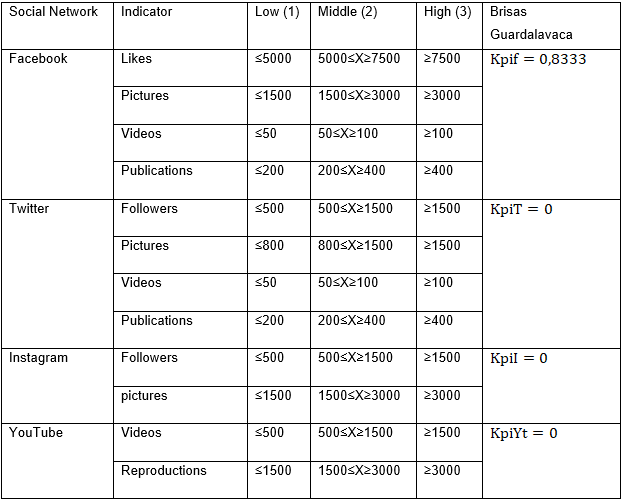
Source: Own elaboration
In the period studied, the Hotel Brisas Guardalavaca only had a presence on the social network Facebook, which is one of the most used in the main markets of the facility, however, the scope and interaction in it is low, as shown in figure 4.
In addition, there is no presence in other social networks of vital importance for these markets such as Instagram, Twitter and YouTube.
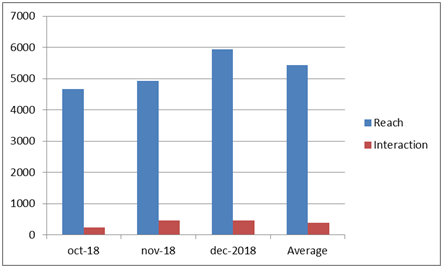
Figure 4. Publications reach and interaction
Source: Elaborated from Facebook Insights
Corporate website
To analyze this aspect, the following elements were audited on the facility's corporate website. The website present at the Hotel Brisas Guardalavaca has been operational since 2002, its last redesign was achieved in 2008 but currently it does not have the necessary visual appeal to compete with other competing websites.
-Positioning: the domain www.brisasguardalavaca.com is located on the first page of the search engine, which undoubtedly represents a good result, however when searching for keywords such as: all-inclusive hotels in Holguín, all-inclusive hotels in Cuba, hotels in Holguín, all-inclusive hotels, hotels in Guardalavaca, among others; the results of the presence of the domain in many of these are not shown, only in hotels in Guardalavaca it appears from the third search page. This result is negative since it limits the access of target markets to the discovery of the product.
-Speed: the website has a loading time of six seconds, which is a moderate time that can be optimized, the optimal value being four seconds of loading
-Links: all links within the web page work correctly
-Architecture: to access the last level of the website it was necessary to make eight clicks, so the optimal value of four is not met.
-Usability: the website has an outdated appearance, without using corporate colors or current themes
Marketing Digital Planeation
To implement the flow within the digital marketing strategy, the first step is to establish a presence on the social networks most used by the main markets that visit the hotel.
Youtube
In all these social networks, the profile of the organization was created, using the username that had been taken for Facebook and which was known among the target audience: @HBrGuardalavaca. Once the institutional profiles were created in these four social networks, the proposed contents for each of the publications were planned, taking into account the objective of each social network and the image that the organization wishes to project.
Content was created that sought to retain the interest of users and achieve interaction with them. These were carried out at least once a day and relevant aspects of the installation are shown, such as the beach, swimming pool, restaurants, rooms, bars, views of the sea, nature, among others. In all the publications, an attempt was made to show activities where the interaction of the clients with them is evidenced.
Once the contents have been generated, the next step was to disseminate them. In the specific case of Facebook, the Creator Study tool was used, which allowed the publications to be scheduled as this tool itself informed of the day and the moment in which the content was generated. the greatest number of visits were made to the page. In the other social networks for the dissemination of content, they were carried out directly from the installation page, as they did not have access from Cuba to the different tools for the programming and segmentation of the publications.
For the generation of potential customers, the two proposed forms were used: active and passive.
Passive: Content was generated on the different social networks and on the website and promoted within these channels, so as users discovered the page, greater interaction was achieved.
Active: Once the contents were generated, an active search was carried out within different groups that contained potential clients and the generated publications were shared within them. The groups where the information was shared contained clients from the public and dealt with topics related to travel and tourism. Among the most used groups are: Travelers and Places, Holguín Cuba, Canadian Travelers, Travel Ideas, World Tourism, among others.
For better functionality, it was decided together with the work team to redesign the facility's web page, for which they had the support of the University of Holguín. As a result, a web page was designed that has the following characteristics (Sierra Guardia, 2020):
Design and organization of content
The new site responds to current web design standards, with a Landing Page full of high quality images, calls to action, animations, all responding to the colors of the Brisas Guardalavaca Hotel's identity manual. It has a news section, which will be linked to the installation's social profiles on Facebook and Instagram, so that the posts made on these profiles will automatically appear in the news section and vice versa.
Additionally, there is a carousel on the main page with Instagram featured photos and all pages and posts made on the website can be shared on social networks directly by customers regardless of their user role. For the positioning of the website the following keywords were used: Cuba hotel, cuba, hotel, beach resort, brisas guardalavaca, Travel to Cuba, holguin, guadalavaca, diving, scubadiving, weddings family-vacation, beach-vacation, all-inclusive -resort, caribbean, tour, excursions, holquin, onlinereservation,cubacan, Cuban Flavor, Hospitality. These allow that any search that is carried out in the search engines that contain the keywords will guarantee a good positioning of the website.
Brisas Guardalavaca's electronic commerce focuses mainly on two elements: B2C and B2B. The B2C will be carried out mainly within the new website, which will have the following characteristics associated with this type of commerce:
-Distribution logistics: it will allow giving information on the price of the purchase based on the purchase, quantity and volume.
-Shopping cart: will allow the customer to know the status of their purchase at all times. In terms of number of rooms, discounts, special offers, stays, etc.
-Credit or electronic payment: this function will not be available from the website, but it will have a link to carry out the purchase on the corporate website of Grupo Cubanacán. However, steps are being taken to implement a payment gateway for both international currencies and the domestic market.
-Registration process: this facility will be available to save the client's preferences and data, and thus speed up the reservation process within the platform.
-Security certificate (SSL): since there is no payment gateway, the presence of a security certificate is not necessary, however, the Cubanacán Group website has the necessary certificates to guarantee transparency and security during the payment process. .
To promote B2B at the Hotel Brisas Guardalavaca, contracts with online travel agencies with a large presence in the international market were strengthened. The following online agencies were prioritized: Booking, Expedia and W2M. The first two are international leaders in terms of level of operation, while W2M focuses mainly on hotel reservations for both physical and online travel agencies.
One of the most important actions when it comes to customer feedback and loyalty is monitoring the mentions of the organization on the internet, for which the Google Alerts tool was used to automatically notify when a publication containing the words Brisas Guardalavaca. Another of the tools used is the follow-up of mentions on Facebook, which will notify each user who tags the hotel in the publications or registers a visit and publishes it on their Facebook profile, in this way the publication will be searched and it will be possible to interact with the client depending on the criteria issued about the installation.
Implementation and evaluation of the impact of digital marketing actions
The digital marketing actions were applied at the Hotel Brisas Guardalavaca in the period from January 2019 to September 2021. The actions that had the most weight in the target audience were established as an order of priorities for the implementation, for which they still exist. proposals that will be implemented in later stages such as the launch of the website. To measure the effectiveness of digital marketing actions, different indicators were evaluated until September 2021.
The institutional profiles were created and put into operation in the four social networks most used by the installation's target market. The increase in organic fans could only be analyzed in the social network Facebook, since it is the only one in which a hotel page was found before carrying out the marketing actions. The growth in this network in the period in which the actions were applied was 5,579 for a monthly growth rate of 4.6%, as shown in Table 2.
This average monthly increase is 271, while from 2014 to December 2018 it was 135.
Table 2. Social Network Followers

Source: Elaborated from Facebook Insights
In the social network Instagram, a good start is achieved in terms of numbers of followers, however, it is limited by technological issues as it cannot use more of its features and its integration with Facebook. These improvements allowed the result of the calculation of the main social network metrics to increase, as shown in the following equation.
(2) KpiRS = (Kpif + Kpit + KpiI + KpiYt) ÷ 4= 0,5208
Electronic commerce in its B2B modality shows a gradual increase in the last period studied due to the hiring of three of the most important Online Travel Agencies in the sector, however, it still represents 10% of the hotel's total income, so Contracting with this type of company should continue to be promoted.
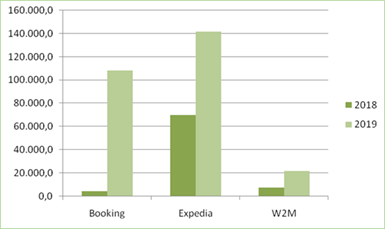
Figure 5. Booking, Expedia y W2M operations
Source: Elaborated from sales report Brisas Guardalavaca 2020
Based on the proposed alternatives, an action plan was developed where initiatives are projected in order to favor the management of digital marketing at the Hotel Brisas Guardalavaca, highlighting the conception of effective email marketing and social media strategies.
Optimization of digital marketing at the Hotel Brisas Guardalavaca
After brainstorming with the working group, it was concluded that the tools that most affect digital marketing management are content generation, electronic commerce in its B2C modality, and the conversion of the target audience into consumers. . However, this does not imply that actions should not be proposed for the other tools.
From the proposal derived from the brainstorm, nine specialists were consulted who presented their criteria regarding the order of priority of these alternatives. The concordance of the evaluations was analyzed taking into account the Kendall concordance coefficient analysis. The processing of the data in SPSS using the indicated method determined that as the level of significance for a value of chi-square = 17, with three degrees of freedom is 0.01 (less than 0.05), the null hypothesis is rejected and it is stated that there is consensus among specialists. The alternatives have the following order of priorities:
-Look for new ways to attract the attention of users and achieve their conversion on social networks
-Delve into the type of specific content for each social network in which there is an institutional account
-Adjust e-commerce actions to the technological capabilities of the territory
-Implement pending digital marketing actions to improve the results achieved
Based on the proposed alternatives, an action plan was developed where initiatives are projected in order to favor the management of digital marketing at the Hotel Brisas Guardalavaca, highlighting the conception of effective email marketing and social media strategies.
CONCLUSION
REFERENCES
Please refer to articles in Spanish Bibliography.
BIBLIOGRAPHICAL ABSTRACT
Please refer to articles Spanish Biographical abstract.